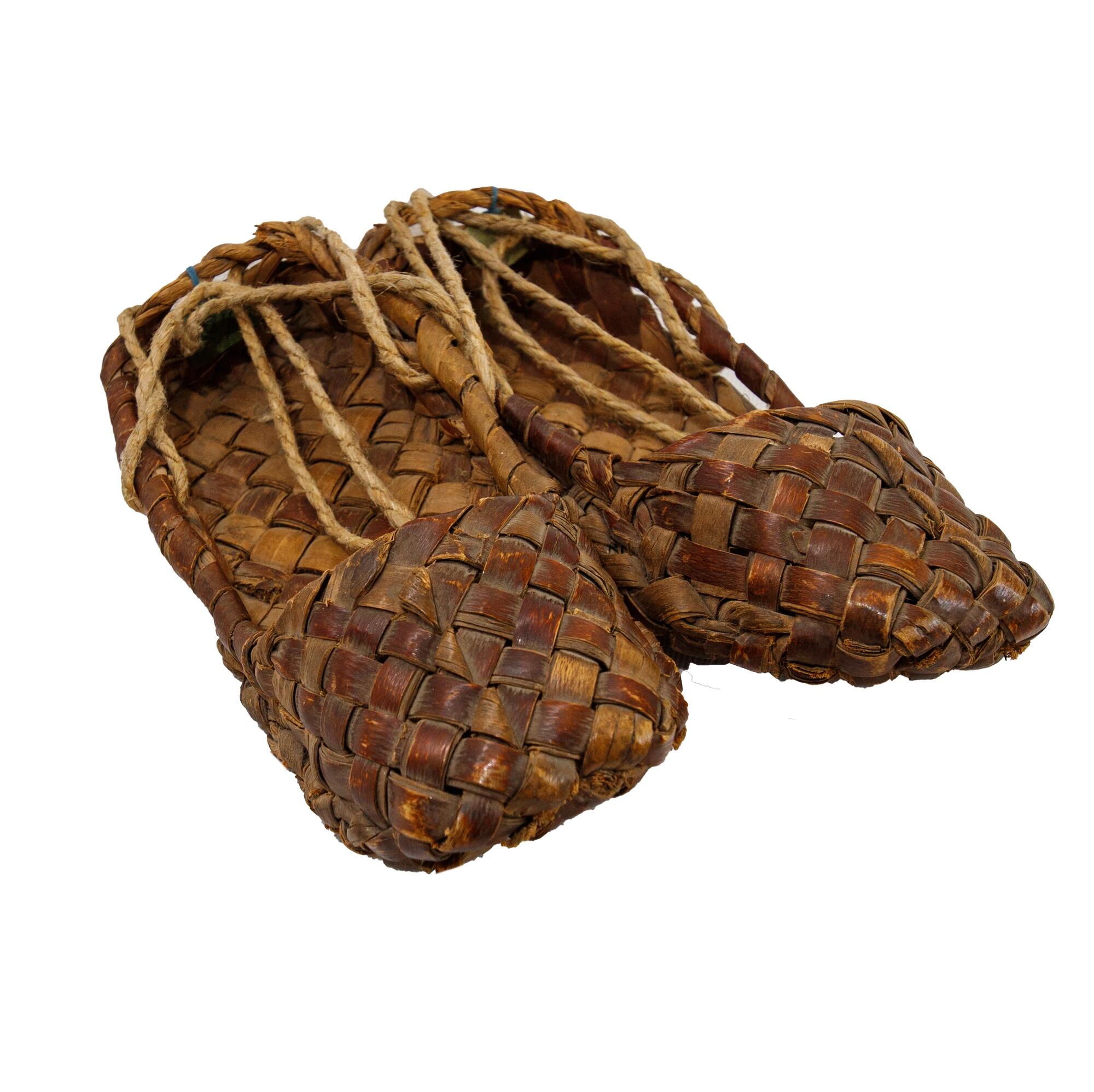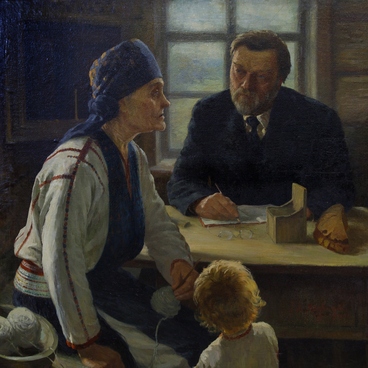The bast shoes are made of elm bast of a reddish hue. On the toe cap there are triangles of bent bast, which are typical for Mordovian lapti, marking the right and left legs.
In Mordovia lapti were made not only for family needs, but also for sale. Shoes were sold in district towns and at trade fairs, where up to 1000 pairs were sold at once. Wholesalers sent that popular kind of shoes to Moscow, Voronezh, Saransk and Nizhny Novgorod.
Lapti were very popular footwear with peasants in the 19th — mid 20th centuries because of their low cost and convenience. ” Boots in the field will not last a week, they break at once, but a pair of lapti last two weeks, ” noted Alexander Gatsinsky, the founder of local history in Nizhny Novgorod. A peasant wore out up to 40 pairs of lapti a year.
Each district had its own wickerwork technique. Diagonal wickered mordovian “karkht” or “kart’” have a trapeze shape, low sides with twisted loops for the rope and a high back were made on the territory of modern Mordovia, as well as in a number of counties of Penza, Tambov, Saratov, Ryazan, and Vladimir provinces.
Mordovian lapti differed in appearance not only from Russian, but also from Mari, Chuvash and Tatar. Mordovian craftsmen invented dual-heeled lapti, which were more expensive than ordinary one-heeled ones. Their back part had two corners, which allowed the shoe to fit the foot better.
The material used was linden bark or bast if to be more precise, which craftsmen bought in bundles at the market. The shoes were made from five, six, seven or ten narrow bast. Festive lapti were created from reddish elm bark and steamed in hot water, which made them even richer in color. From a selected amount of bast they wove first the heel, then the bottom of the foot and in the last turn the head. The weaving was finished by attaching loops for ropes on the sides.
Making one pair of lapti took 3-4 hours. An experienced craftsman produced 4-5 pairs a day, and about 25 pairs a week. Mostly elderly men made wicker shoes from autumn to spring when they were not engaged in agricultural work. The cost of a pair of lapti in the market depended on the season: in fall and winter they cost 3 to 6 kopecks for a pair, in spring and summer — from 8 to 20 kopecks. The centers of the making lapti industry were the Mordovian villages of Kuchenyaevo, Alatyrsky and Sudosevo, Karsunsky districts of Simbirsk province.
In Mordovia lapti were made not only for family needs, but also for sale. Shoes were sold in district towns and at trade fairs, where up to 1000 pairs were sold at once. Wholesalers sent that popular kind of shoes to Moscow, Voronezh, Saransk and Nizhny Novgorod.
Lapti were very popular footwear with peasants in the 19th — mid 20th centuries because of their low cost and convenience. ” Boots in the field will not last a week, they break at once, but a pair of lapti last two weeks, ” noted Alexander Gatsinsky, the founder of local history in Nizhny Novgorod. A peasant wore out up to 40 pairs of lapti a year.
Each district had its own wickerwork technique. Diagonal wickered mordovian “karkht” or “kart’” have a trapeze shape, low sides with twisted loops for the rope and a high back were made on the territory of modern Mordovia, as well as in a number of counties of Penza, Tambov, Saratov, Ryazan, and Vladimir provinces.
Mordovian lapti differed in appearance not only from Russian, but also from Mari, Chuvash and Tatar. Mordovian craftsmen invented dual-heeled lapti, which were more expensive than ordinary one-heeled ones. Their back part had two corners, which allowed the shoe to fit the foot better.
The material used was linden bark or bast if to be more precise, which craftsmen bought in bundles at the market. The shoes were made from five, six, seven or ten narrow bast. Festive lapti were created from reddish elm bark and steamed in hot water, which made them even richer in color. From a selected amount of bast they wove first the heel, then the bottom of the foot and in the last turn the head. The weaving was finished by attaching loops for ropes on the sides.
Making one pair of lapti took 3-4 hours. An experienced craftsman produced 4-5 pairs a day, and about 25 pairs a week. Mostly elderly men made wicker shoes from autumn to spring when they were not engaged in agricultural work. The cost of a pair of lapti in the market depended on the season: in fall and winter they cost 3 to 6 kopecks for a pair, in spring and summer — from 8 to 20 kopecks. The centers of the making lapti industry were the Mordovian villages of Kuchenyaevo, Alatyrsky and Sudosevo, Karsunsky districts of Simbirsk province.



